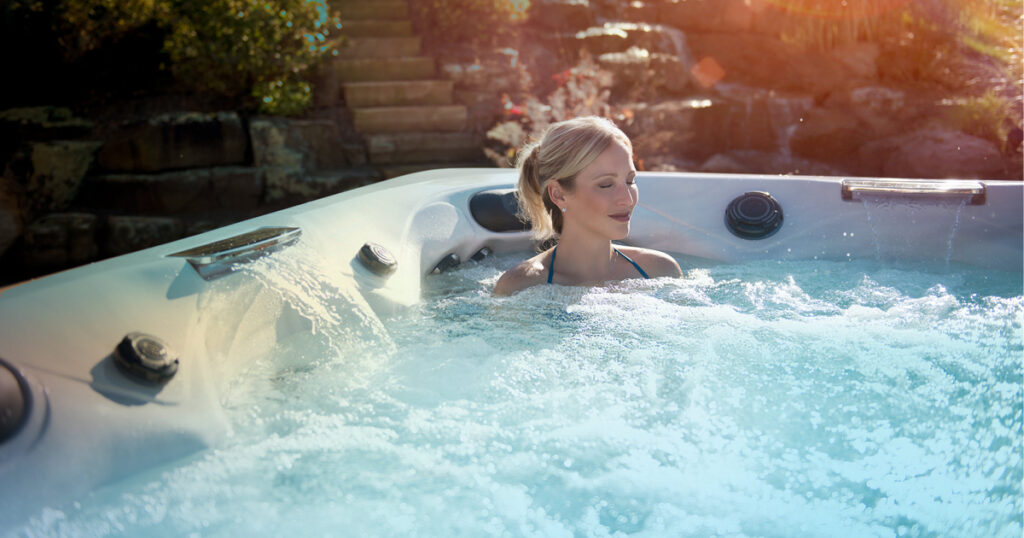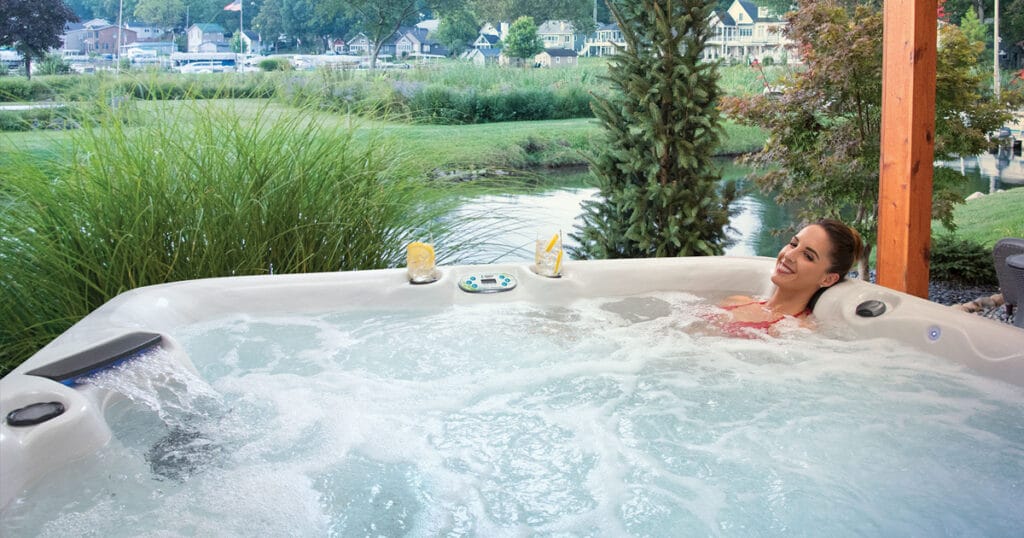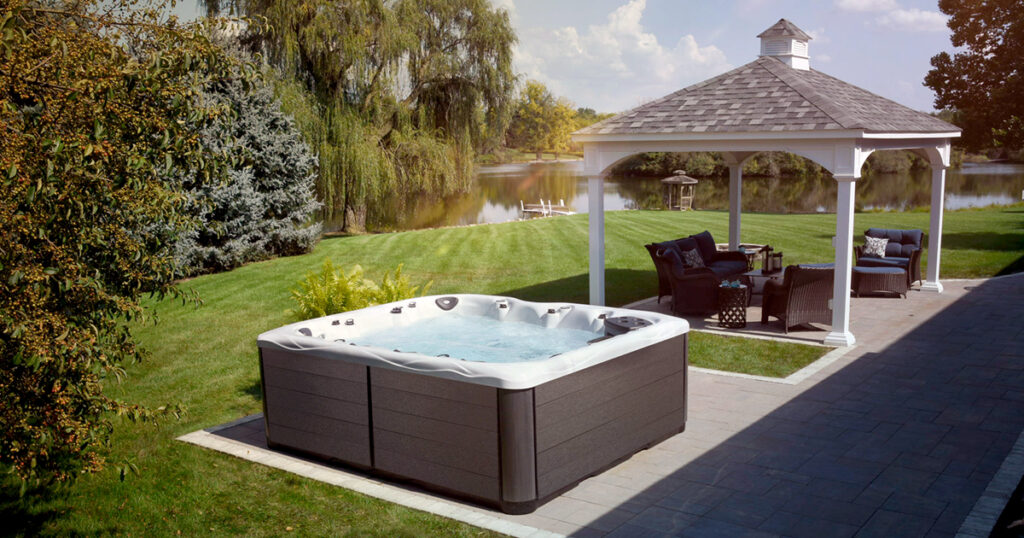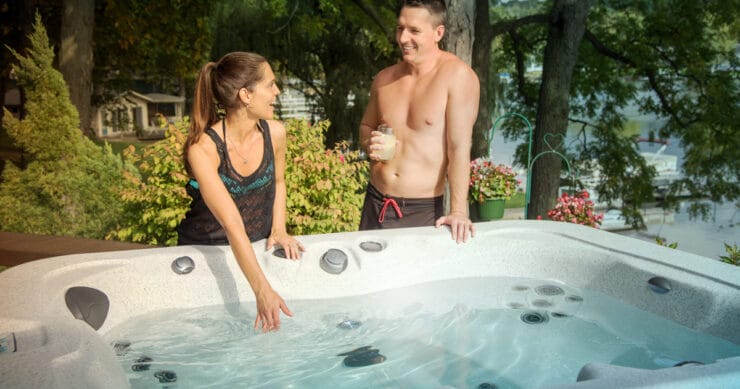Can a hot tub be too hot? Your first reaction might be to say no. However, if you have ever dipped your toe in a hot spring or other spa where the water is 106 degrees or hotter, you might change your mind.
The water is soothing but it is not ideal for soaking for more than 5 or 10 minutes. Hot tubs are designed to be used at a safe yet therapeutic temperature of 104 degrees or lower. You can soak for 20 minutes or longer, enjoying the relaxation that only a hot tub provides.
There are times when your hot tub water can get too hot. Before you worry that there is a problem with your spa, check your weather app. When the weather is hot and humid, the water temperature of your hot tub can increase, even when the heater is not on.
So what do you do when your hot tub overheats, so to speak? These tips and tricks will help you lower the hot tub temperature so you can enjoy your spa this summer and all of the seasons that follow.
Perfect hot tub temperature
What should the temperature of your hot tub be? The perfect temperature is a combination of therapy, safety, and personal preference. Other considerations include whether you will have children or pregnant women in your hot tub.
The highest temperature to which you can set your hot tub is 104 degrees. However, most people are comfortable when the water is between 100 degrees and 102 degrees.
The U.S. Consumer Product Safety Commission recommends a lower hot tub temperature for pregnant women — 100 degrees. Pregnant women, according to the American College of Obstetricians and Gynecologists, should not let their core body temperatures rise above 102.2 degrees.
When children are using the hot tub, the Pool and Hot Tub Alliance recommends setting the spa to 98 degrees.
If you don’t know how hot to set your hot tub water, consider starting with setting it to 99 degrees. You can gradually increase the water temperature if it does not feel soothing or comfortable.

Why your hot tub is overheating
Your hot tub is supposed to help ease your worries. However, when the water temperature reads 106 degrees or hotter, you might feel concerned and wonder how it happened.
There are a combination of factors that can cause overheating, also called thermal heat creep.
Ambient temperature
The air temperature, humidity, and cloud cover can affect your ability to maintain a comfortable water temperature. The hotter and sunnier it is, the more likely you are to experience heat creep.
Filter cycle
Most Master Spas hot tubs will filter water twice a day. However, the length of the filter cycle will depend on your settings. The water will warm up during the filter cycles for two reasons — it’s moving through the heater and the pump generates heat.
Hot tub location
Do you find that your hot tub is overheating? It might be because of where you installed it. If your spa is out in the open or gets a lot of sun, you might struggle with overheating.
Spa insulation
Master Spas are built with energy-efficient components, such as full-foam insulation and a bifold cover. These features are designed to keep the heat in and the elements out. In addition, they lead to energy savings and reduce energy costs compared to other spas.

Cool down your hot tub
What should you do when your hot tub temperature creeps up in summer?
Here’s how to keep your hot tub operating its best and keep the water comfortable, even on the hottest days.
Turn down the temperature
This solution seems like the most obvious. While you might prefer to soak in water that’s between 100 and 102 degrees, try setting the spa to 98 degrees. Changing the temperature will prevent the heater from kicking on and further warming up the water.
Adjust the filter cycles
Filtration cycles are key to keeping your water clean and clear. However, when the filters are running, the water moves through the heater. You can change your filtration cycles to run only during the coolest part of the day. You can also reduce the amount of time the water is filtering so long as your water quality is not affected.
Cool off with cold water
How do you cool off on a hot summer day? Splashing cold water on your face might be an easy option. The same could be said for your hot tub. You can partially drain your spa, adding in freshwater. The water from your garden hose will be at a much lower temperature. After adding some cool water, your hot tub should be able to better maintain a more comfortable water temperature.
Open air
The air valves of your hot tub inject air into the flow of water, helping to create “bubbles” and increase the pressure. You might close them after the end of a soak. But if you need to lower your water temperature, keep the air controls in the open position when not in use.
Incorporate shade
The heat from the sun will not only warm you up. It will also warm up your hot tub water. Backyard shade elements, such as gazebos, sails, and canopies, can provide the shade you are seeking. In addition, they can help prevent the sun from heating up your spa water. Shade sails are particularly popular because they can be easily adjusted or taken down depending on the season. A very simple solution is a pop-up canopy, which can be used when it’s particularly hot or you want a temporary solution.
Vent your hot tub cover
An easy way to cool down your spa water is to vent your hot tub cover. Using a pool noodle or folded towel, place something under all four corners of your hot tub cover. This process allows the night air to circulate and cool off the water.

Hot tub insulation
The insulation of your hot tub is what helps keep your hot tub water hot. In addition, it helps protect the components and plumbing of your spa.
Master Spas uses a full foam insulation, which is sprayed into the cabinet of the spa. Benefits of this type of insulation include a lower cost to operate the spa; components last longer; and structural support. In addition, it allows homeowners to use their hot tubs year-round, even in colder climates.
Of course, if you are facing thermal heat creep, you might not be worried about those cold winter days. In fact, you might even be tempted to remove some insulation to see if it allows heat to escape.
It’s important to keep in mind that the insulation is doing its job. Removing insulation can cause damage not covered under your warranty.
How to buy a hot tub
Are you ready to upgrade your backyard in 2022? A Master Spas hot tub can help you relax and unwind in the convenience of your backyard. You can click here to discover our secrets to creating a backyard oasis. Or, contact your local Master Spas retailer to learn more about hot tub ownership. Wondering how much a hot tub costs? You can request a quote here.


